ISSN ONLINE(2319-8753)PRINT(2347-6710)
ISSN ONLINE(2319-8753)PRINT(2347-6710)
DING Jihui1 , WANG Weiyu2 , ZHAO Tuo2, FENG Junhi3 , QUAN Xiaojuan3
|
| Related article at Pubmed, Scholar Google |
Visit for more related articles at International Journal of Innovative Research in Science, Engineering and Technology
Blasting are adopted to simulate the natural earthquake, through the field test of composite foundation and natural foundation, dynamic characteristics and attenuation law are studied. The experiment results show, the horizontal main vibration frequency of natural foundation is at 8.2 ~ 9.03 Hz and the vertical is at 7.75 ~ 9.16 Hz; the horizontal main vibration frequency of composite foundation is at 8.02 ~ 9.90 Hz and the vertical is at 8.36 ~ 9.70 Hz. Measuring point frequency of natural foundation and composite foundation is near to the first-order natural frequency. Effects of the implanting pile in the natural foundation are little on the frequency. Vibration attenuation of acceleration peak in the natural foundation and composite foundation is fitted in exponential attenuation, the attenuation rate in composite foundation is faster than natural foundation, and then composite foundation is good for the anti-seismic of the upper structure.
Keywords |
| blasting vibration, natural foundation, composite foundation, dynamic characteristics, Vibration attenuation |
I. INTRODUCTION |
| The composite foundation is that the part soil body in the natural ground foundation is reinforced or replaced during the ground treatment, and load is born by reinforced body and soil body around the pile[1].With the rapid development of economy, the strength and stiffness of the pile in composite foundation have greatly increase, bearing capacity of composite foundation is greatly improved, the already existing theory can not meet the requirements, and then the dynamic problems in the composite foundation have become the hot spots, therefore, introducing the seismic design concept in composite foundation has the vital significance. Study on the seismic behavior of composite foundation is mainly using large-scale FEM numerical analysis software to simulate composite foundation [2,3,4,5]. The simulation method is still in the theoretical level, not used in practical design. Under the action of blasting vibration, dynamic characteristics and influencing factors in soil-cement pile and CFG pile composite foundation are studied by Wang Weiyu, Zhao Tuo, Ding Jihui [6,7,8,9]. Blasting are adopted to simulate the natural earthquake, through the field test of composite foundation and natural foundation, dynamic property and attenuation are researched. |
II. THE INTRODUCTION OF THE TEST SITE |
| The test site is located in Shijiazhuang Heibei province. In the 20 m depth, the soil layers mainly are yellow silt clay, fine sand, middle sand and silt clay. In the 20m driving depth, the underwater is not seen. There is not the harmful geologic action in the site. The main parameters of soil layer as shown in Table 1. |
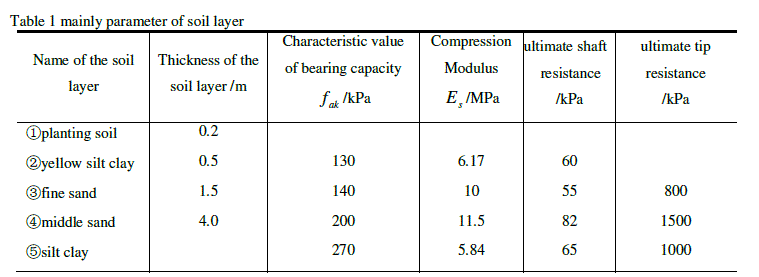 |
III. MOEL TEST AND SCHEME OF THE FIELD |
| Two kinds of composite foundation model are designed: CFG composite foundation, the composite foundation combined with CFG long pile and CFG short pile. The model design parameter of composite foundation is shown in table 2. CFG pile adopts C20 commercial concrete. Blasting is used as the vibration resource. Blasting hole is made by LuoYang shovel, the hole diameter is 50 mm, and the hole depth is 6m. The Explosives are buried in the hole and than backfill tamping. The vibration is picked by acceleration sensors. The arrangement of the piles and measuring elements are shown in Fig.1. |
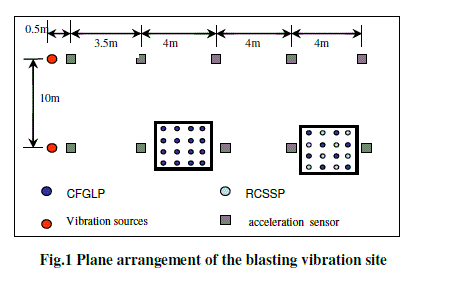 |
 |
IV. THE ANALYSIS OF EXPERIMENT TESULT |
| Vibration Acting Time. Table 3 is the vibration start time and end time for each measuring point in natural foundation. As shown in table 3, horizontal vibration acting time is at 0.30 ~ 0.54s for each measuring point in natural foundation, vertical vibration acting time is at 0.36 ~ 0.52 s, and horizontal vibration acting time is close to the vertical. With the increase of the distance from the measuring points to vibration recourse, the vibration acting time has been increased. For composite foundation, the vibration duration has little difference with natural foundation. |
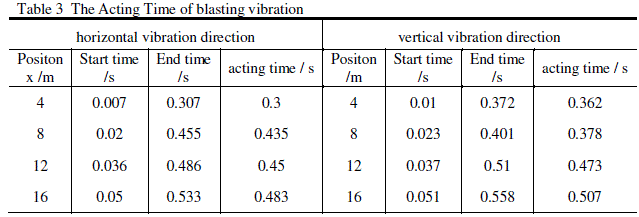 |
| The Main Frequency of Vibration. Table 4 is horizontal and vertical main vibration main frequency of each measuring point in natural foundation and composite foundation. As shown Table 4, in addition to the individual points, the horizontal main vibration frequency of natural foundation is at 8.2 ~ 9.03 Hz and the vertical main vibration frequency is at 7.75 ~ 9.16 Hz; The horizontal main vibration frequency of composite foundation is at 8.02 ~ 9.90 Hz and the vertical main vibration frequency is at 8.36 ~ 9.70 Hz. Through the modal analysis, the horizontal first-order natural frequency is 8.74 Hz and damping ratio 0.1233 in natural foundation, the vertical first-order natural frequency is 8.29Hz and damping ratio is 0.0983. The horizontal first-order natural frequency is 8.93 Hz and damping ratio 0.0939 in natural foundation, the vertical first-order natural frequency is 8.28Hz and damping ratio is 0.1923. Measuring point frequency of natural foundation and composite foundation are near the first-order natural frequency, and effects of the implanting pile on site are little on the frequency. |
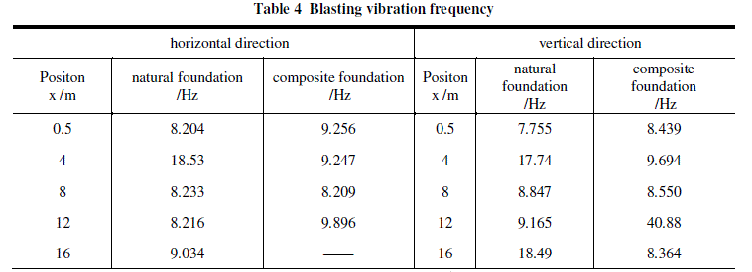 |
| The analysis of acceleration peak under blasting vibration. Table 5 is the acceleration peak in natural foundation and composite foundation under the condition of 1.05kg charge and 6m buried depth. The acceleration peak fitting curve satisfies the following formula: |
 |
 |
 |
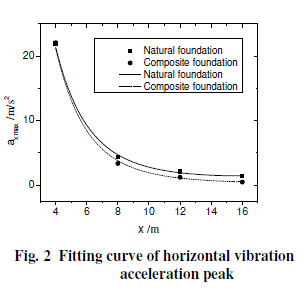 |
| The results are as follow from the table 6, Fig. 2 and Fig. 3. |
| (1) When the horizontal distance x at a certain level, the vibration acceleration peak of the composite foundation surface is less than natural foundation. With the increase of the horizontal distance x , the decreasing degree of the composite foundation vibration acceleration peak increases. When the depth is 6m, the charge is 1.05kg, the horizontal distance x is 16m, compared with the natural foundation, the horizontal acceleration peak decreases 66.45%, vertical acceleration peak decreases 13.98%. |
| (2) Under the same condition of blasting vibration, the horizontal vibration peak acceleration and the vertical vibration acceleration decreases rapidly with increasing horizontal distance x . When x is at 4m~16m, horizontal vibration acceleration peak in natural foundation decreases 93.7%, and vertical vibration acceleration peak decreases 88.4%; Horizontal vibration acceleration peak in composite foundation decreases 97.9%, and vertical vibration acceleration peak decreases 90%; Vibration acceleration peak attenuation in composite foundation is faster than natural foundation. |
| (3) Under the same condition of blasting vibration, when x is at 4m~8m, horizontal vibration acceleration peak in natural foundation decreases 17.64m/s2, and vertical vibration acceleration peak decreases 16.62m/s2; Horizontal vibration acceleration peak in composite foundation decreases 18.75m/ s2, and vertical vibration acceleration peak decreases 16.92m/s2; when horizontal distance x is 8m~16m, horizontal vibration acceleration peak in natural foundation decreases 2.93m/ s2, and vertical vibration acceleration peak decreases 2.89m/ s2; Horizontal vibration acceleration peak in composite foundation decreases 2.87m/ s2, and vertical vibration acceleration peak decreases 2.9m/ s2. Within 8m range from the vibration resource vibration acceleration peak attenuation fast, and then gently. |
V. CONCLUSION |
| Using the engineering blasting as the vibration resource, vibration attenuation experiment in natural foundation and composite foundation is made in the test site, conclusions are obtained as the following: |
| Under the same depth and charge, the vibration acting time of measured point is at 0.30~0.51Sec. The horizontal main vibration frequency in natural foundation is at 8.2~9.03Hz, and the vertical main vibration frequency is at 7.75~9.16Hz; the horizontal main vibration frequency in composite foundation is at 8.02~9.90Hz, the vertical main vibration frequency is at 8.36~9.70Hz. Natural foundation and composite foundation of the dominant frequency in the vicinity of the first-order natural frequency. Measuring point frequency of natural foundation and composite foundation are near the first-order natural frequency, and effects of the implanting pile on site are little on the frequency. |
| Under the same depth and charge, when the horizontal distance from measuring points to the vibration resource at a certain level, composite foundation surface vibration acceleration peak is less than natural foundation. With the increase of the horizontal distance from measuring points to the vibration resource, composite foundation vibration acceleration peak of the measured points on surface is in the lower degree increase. Vibration attenuation of acceleration peak in the natural foundation and composite foundation are calculated by exponential attenuation, the attenuation rate in composite foundation is faster than natural foundation. |
VI. ACKNOWLEDGMENTS |
| This work was supported by The Natural Science Foundation of Hebei Province under Grant (No. 2011- E080601). |
References |
|